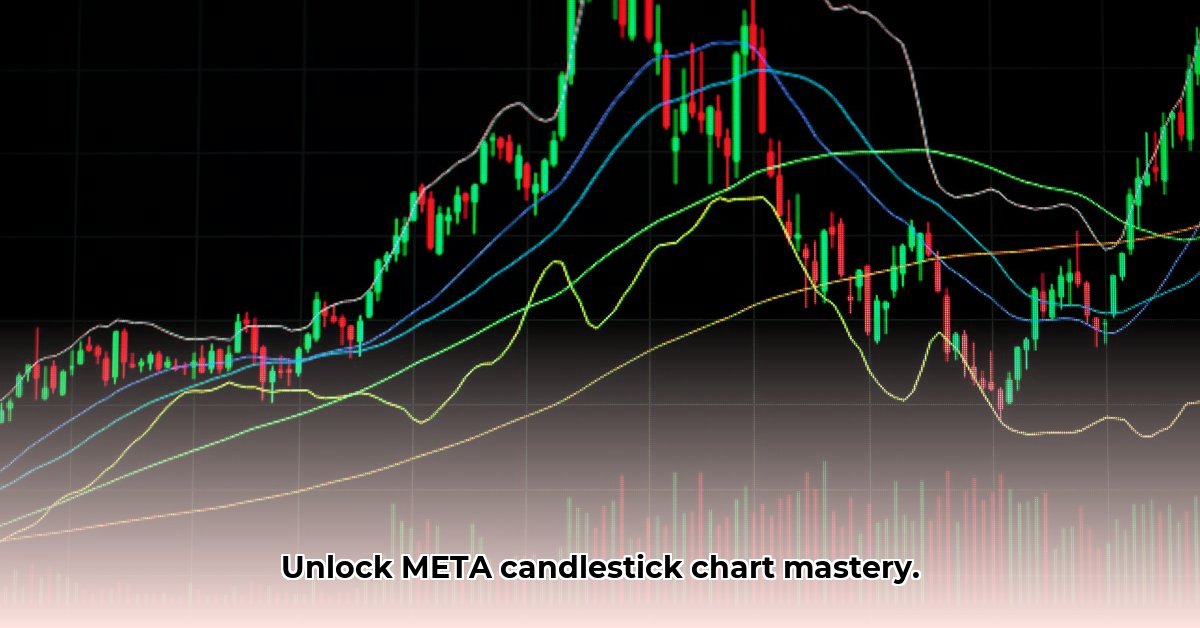
Meta Candlestick Chart Analysis: A Beginner's Guide
This guide provides actionable intelligence on using candlestick charts to analyze META stock price behavior. We'll cover fundamental concepts, advanced techniques, and risk management strategies, suitable for both novice and experienced traders. Remember, candlestick analysis is just one tool; combining it with other forms of analysis creates a more robust trading strategy. Can you confidently identify bullish and bearish candlestick patterns in META's price history?
Let's begin by understanding the basics. Each candlestick represents a specific time period (e.g., daily, hourly), showing the opening, closing, high, and low prices. The body's color indicates whether the closing price was higher (green/white, bullish) or lower (red/black, bearish) than the opening price. The wicks (upper and lower shadows) extending from the body illustrate the price range beyond the open and close. By analyzing these candles, we can identify potential price movements and trends.
Deciphering Key Candlestick Patterns
Several candlestick patterns offer insights into potential price direction. However, remember that these are indicators, not guarantees. Confirmation from other technical indicators and fundamental analysis is crucial for robust trading decisions.
Hammer (Bullish): A small real body (body of the candle) at the bottom of a price range with a long upper wick, suggesting a potential price reversal. Think of it as a signal that buyers are stepping in, potentially leading to an upward movement.
Shooting Star (Bearish): The opposite of a hammer, with a small real body at the top of a price range and a long lower wick. This suggests potential selling pressure and a possible downward price trend.
Engulfing Pattern (Bullish or Bearish): Consists of two candles where the second candle completely engulfs the first. A bullish engulfing pattern occurs when a larger green candle follows a smaller red candle, potentially signaling a shift to bullish momentum. A bearish engulfing pattern, conversely, signifies a potential shift to bearish momentum.
| Pattern | Description | Potential Signal | Confirmation Needed? |
|---|---|---|---|
| Hammer | Small real body at the bottom with a long upper wick. | Possible upward price turn | Yes, from other indicators and analysis |
| Shooting Star | Small real body at the top with a long lower wick. | Possible downward price turn | Yes, from other indicators and analysis |
| Engulfing Pattern | Second candle completely surrounds the first (color dependent for bullish/bearish) | Potential trend change (up or down) | Yes, confirmation is usually required |
Timeframe Analysis: Zooming In and Out for Clarity
Analyzing META stock across different timeframes (daily, weekly, hourly) provides a more comprehensive perspective. Short-term charts (e.g., hourly) reveal quick fluctuations, while longer-term charts (e.g., weekly) show broader trends. Using multiple timeframes helps identify both short-term trading opportunities and long-term investment strategies. What insights might you gain by comparing a daily chart to an hourly chart of META?
Integrating Candlestick Analysis with Other Tools
For best results, combine candlestick analysis with other market analysis tools. This approach offers a more balanced and well-rounded trading strategy.
Technical Indicators: Moving averages, Relative Strength Index (RSI), and MACD. These indicators can confirm or contradict the signals from candlestick charts, adding another layer of confirmation.
Fundamental Analysis: Reviewing META's financial reports, news releases, and industry trends adds a non-technical perspective. Strong fundamentals can enhance a bullish candlestick pattern's predictive power.
Market Sentiment: Gauging overall market sentiment towards META (or broader market trends) allows for better context when interpreting candlestick patterns. Are other similar stocks showing similar patterns?
"Combining candlestick patterns with other analytical tools greatly improves accuracy and reduces the risk of false signals," says Dr. Eleanor Vance, Professor of Finance at the University of California, Berkeley.
Mastering META Candlestick Charts: A Step-by-Step Action Plan
Define Your Trading Style: Choose between short-term trading (day trading, swing trading) or long-term investing. This directly impacts your timeframe choice and risk tolerance.
Learn Fundamental Patterns: Master the identification of common patterns (hammers, shooting stars, engulfing patterns). Practice is key.
Integrate Other Analyses: Combine candlestick analysis with technical indicators and fundamental analysis for well-rounded decision-making. Use multiple data points to create a more robust strategy.
Implement Risk Management: Always use stop-loss orders to limit potential losses. Diversify your portfolio to decrease the overall risk.
Refine Your Strategy: Continuously monitor your trades, learn from mistakes, and adapt your strategy based on new market conditions and observed patterns. "Trading is a continuous learning process," advises Mr. David Lee, Senior Portfolio Manager at Goldman Sachs.
This concludes our guide to mastering META candlestick charts. Consistent practice and continuous learning are vital for success. Remember, no system is foolproof, so responsible risk management is paramount.